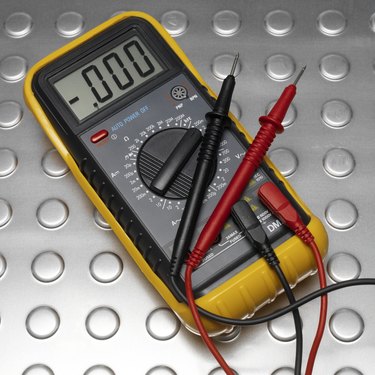
An electronic transistor is essentially two diodes. Diodes and transistors are either in service or not since neither are known to wear out gradually. Any component that goes bad in a circuit can prevent it from functioning. Transistors perform an important duty in circuits, and if they are shorted out or open they will cause the circuit to fail. Test the transistors in faulty electronics to find out if problems can be fixed by replacing them.
Step 1
Turn off the power to the circuit before testing. Unplug the AC power cord and/or remove the battery supplying power. Exhaust power from all capacitors on the board. Touch both the terminals on a capacitor simultaneously with a metal screwdriver that has an insulated handle to cancel out the stored power.
Video of the Day
Step 2
Identify the base, collector, and emitter leads on a transistor. The leads may be labeled B, E, and C or the orientation within the circuit may reveal which lead is which. Consult an electronics supplier catalog for exact orientation of the leads on particular transistors if no positive identification is present.
Step 3
Set a digital multimeter to a diode setting if it has one; use an ohms setting otherwise. Use a low ohms scale setting on analog meters.
Step 4
Check the base to collector readings in both directions. Touch one lead from the meter to the base lead and the other to the collector lead. Look at the reading, then reverse the leads. A good reading will show infinity in one direction and give a reading of about 600 in the other.
Step 5
Check the base to emitter readings in both directions. Touch one lead to the base and the other to the emitter. Check the meter and reverse the leads to read the opposite direction. Good readings should show infinity in one direction and close to 600 in the other.
Step 6
Remove the base lead if the numeric readings are far from 600. Other electronic components like resistors may affect the readings from a transistor within a circuit. Use a soldering iron to melt the solder holding the base lead of the transistor to the circuit board and pull the base lead out of the board so it's not connected to the circuit. Then use the meter to test both directions from base to collector and base to emitter again. Use the solder iron to melt the solder over the hole the base lead occupied and push the base lead back into that hole in the board after taking meter readings.
Step 7
Replace a transistor if either the base to emitter or base to collector readings show zero in both directions or infinity in both directions. Zeros reveal a short while infinities indicate an open diode within the transistor.
Video of the Day